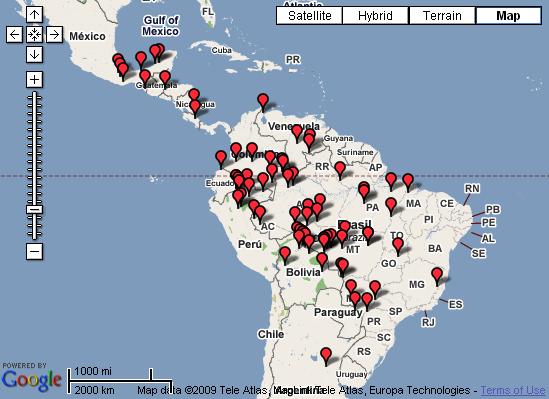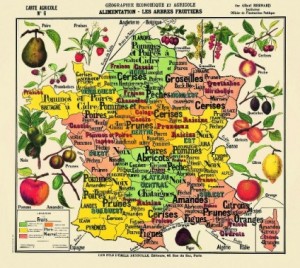- Psst, wanna breed a cucumber? With video goodness.
- Hudson Valley Seed Library.
- “One duck creates boundless treasure.â€
- Potato spindle tuber viroids go back to the beginning of life on Earth. Kinda.
- AGCommons’ Quick Wins: geospatial technology for smallholder farmers. Via.
More on mapping agrobiodiversity threats
Hot on the heels of a map showing how warfare has spared hardly any biodiversity hotspot in the past 50 years comes one on another possible threat to agricultural biodiversity. UNESCO has just announced the publication of its Atlas of the World’s Languages in Danger. There’s a great interactive website all ready for people to start playing with. Below is a screen shot (there doesn’t seem to be a way to export maps, alas) showing critically endangered languages with fewer than 50 speakers in South and Central America. Worldwide there are 318 such languages.
I’d say a disappearing language was a pretty good proxy for risk of crop genetic erosion. So much to mash up, so little time.
Mapping agrobiodiversity, then and now
I found this great 19th agricultural map of France at Mapping the Marvelous, a feed I’ve only recently subscribed to which is proving a real find. It was linked there to a post about city orchards at a blog called Food Mapping, a “visual exploration and mapping out of the issues surrounding local food, including the associated debates regarding economics, environmentalism, geography, sustainability and taste.” That’s also gone into the feed reader.
Nibbles: Easter Island, Quail, Kimchi, Assisted migration, Solar, Training materials, Ancient wine squared, Economics, Wild food
- People of Rapa Nui innovated as they collapsed.
- “Extinct” Bird Seen, Eaten. Sorry, National Geographic, but I can’t better that headline. Worthy of Fark.
- Kimchi madness.
- Coming to a protected are near you: moving species to save them from climate change. CWR, anyone?
- Shrinking the C footprint of traditional peanut processing. Via.
- 15 Evolutionary Gems: alas, nothing from crops, livestock. Surely domestication could have made it in there.
- “Bulgarian wine cellars have already announced that they will plant vines with the mysterious and newly recovered variety of grapes near the Orpheus tomb.”
- And more ancient wine, this time from Malta.
- Bioversity International wises up on dismal science, launches new economics webpages.
- Wild forest foods big hit at FAO booth at Lao and International Food Festival last weekend in Vientiane.
Mapping sustainability
Resilience Science points to many efforts to use community mapping as a force for development and empowerment. Sometimes, in our cups, we dream of a set of globally connected maps devoted to agricultural biodiversity. Something really simple, like performance reports from specific crops, varieties and types of farm could be linked with geodata which in turn would allow it to be linked to all manner of environmental data. It would grow into the database that ate the world, but more to the point could help feed the world.
Of course, dreaming doesn’t make it so, but Green Maps seems to put all the tools at anyone’s disposal. Is anyone out there doing anything for agrobiodiversity? I searched, but couldn’t find anything except for urban outlets for the products of sustainable farms. Important, but not enough.

